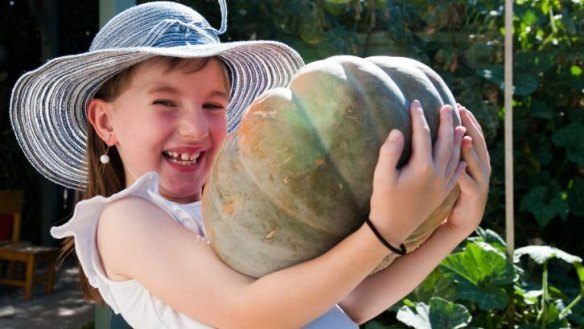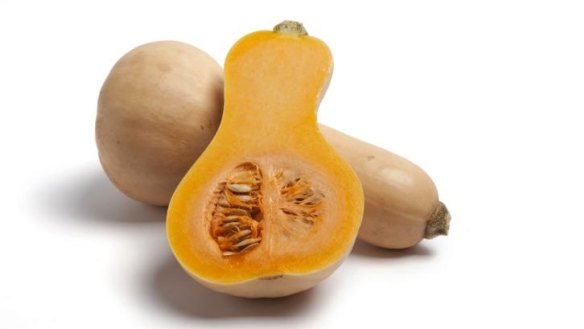Pair struck gold in their Hawker pumpkin patch

A Hawker couple have created a flourishing garden where organic principles, heirloom plants and open pollinated seeds come together to create a rich harvest.
In John and Andrea Carroll's front garden, John has built seven raised beds.
Now well established, the beds contain white corn, heirloom tomatoes, cucurbits, red onions, potatoes, lettuce, sunflowers, carrots and the best 10 plants for bees, including yarrow, basil, mint, alyssum and borage.

They divide the tasks: John does the digging and looks after the chickens and lawn, while Andrea is the artistic director, choosing seeds, seedlings and flowers, and planting often by the moon or folklore.
Andrea was born and raised in Hobart where her parents were keen organic gardeners before the term even had a name, so she follows those principles. She has lived in Canberra for 20 years, but John moved to the city from Sydney and the couple moved to Hawker in 2009.
Andrea chooses heirloom and open pollinated seeds from 4Seasons, Diggers and other organic companies, and buys some seedlings from Kingston markets.
To the vegie beds' soil they have added cow manure, sugar cane mulch, chicken manure and straw from the henhouse and they compost all kitchen scraps.
They are committed to burying all their prunings, a method akin to Hugelkulture, the idea that prunings break down and feed the soil, and turn into mycellium, which becomes the basis of good soil health. It also helps with water retention.
Mustard seed is grown as a green manure and a one-kilogram bag of black mustard seeds from an Indian grocer in Belconnen goes a long way providing the family with tiny leaves for winter salads and handfuls for chook food.
When the plants are going to seed, they bring beneficial predators such as hover flies and aphids to the garden. They feed the aphids to the five Isa Brown hens, which lay plentifully. The crop is then slashed down and dug into the soil.
In the back garden, Blue Lake beans and Parisian pickling cucumbers climb a frame beside the chook house, while tromboncino zucchini plants and pumpkins scramble over the ground and up the sides of one of two water tanks, one with a 3000-litre and the other 5000 litres. Zucchinis are served for afternoon tea in a moist zucchini and chocolate cake.
Andrea's pride and joy are the French heirloom Musquee de Provence pumpkins, which were raised from Diggers seed, growing three plants in one spot. The largest pumpkin is around 10 kilograms and their six-year-old daughter Mary struggled to lift it for our photo.
Though it is a perfectly fluted, handsome vegetable, Andrea says its flesh is too wet to roast, so she turns it into soup, which brings out the colour of the deep coral-orange flesh (recipe below).
In a side bed is a strawberry patch created for their two-year-old son Leroy. Andrea is growing the French alpine strawberries Reine des Vallees in 20 kilogram coffee sacks given to her for free by a local coffee roaster.
They found the idea to tidy up a border from Tino Carnevale on Gardening Australia. The sacks are filled with compost-rich soil and, as the bed is watered, the hessian gradually breaks down.
The plants produce enough for Leroy to eat a a few of the tiny fruit with their exquisite distinctive taste most days.
Andrea lived for some time in Japan, which prompted her to grow eggplants, with mixed success.
She says anyone who has tried nasu dengaku knows why she loves them. The silky, caramelly dish is made by cutting eggplants in half and grilling them topped with sweet miso paste. Her favourite recipe comes from pickledplum.com.
Fermented foods and drinks are also popular with the Carrolls. Andrea has grown sugar loaf cabbages for sauerkraut, but also uses Savoy or red cabbages and Parisian pickling cucumbers from the garden.
She makes kimchee from French Creole garlic, and also loves kombucha, which we saw fermenting in the kitchen in large jars topped by clean, recycled baby's bibs during our visit.
Both recipes come from thekitchn.com
ANDREA'S FRENCH PUMPKIN SOUP
3-4kg whole French Musquee de Provence pumpkin
2 red Spanish onions, roughly chopped
3 cloves garlic
1 carrot
1 stick of celery
2 litres homemade or store-bought chicken or vegetable stock
Celtic sea salt and black pepper to taste
extra water to adjust consistency, if necessary
Heat oven to 180C. To avoid chopping and peeling, cut a hole in the top of the pumpkin, remove any stalk and place the pumpkin on a baking tray in the centre of the oven.
When the pumpkin starts to shrink, let it cool and take out the seeds and scoop out the flesh. (Seeds and skin can be composted.)
In the meantime, chop peeled vegetables roughly and add with stock to a large pot on the stove to soften, and add pumpkin flesh.
When cooked, puree and serve with a dollop of creme fraiche or add coconut cream and chopped fresh oregano or basil.
Susan Parsons is a Canberra writer